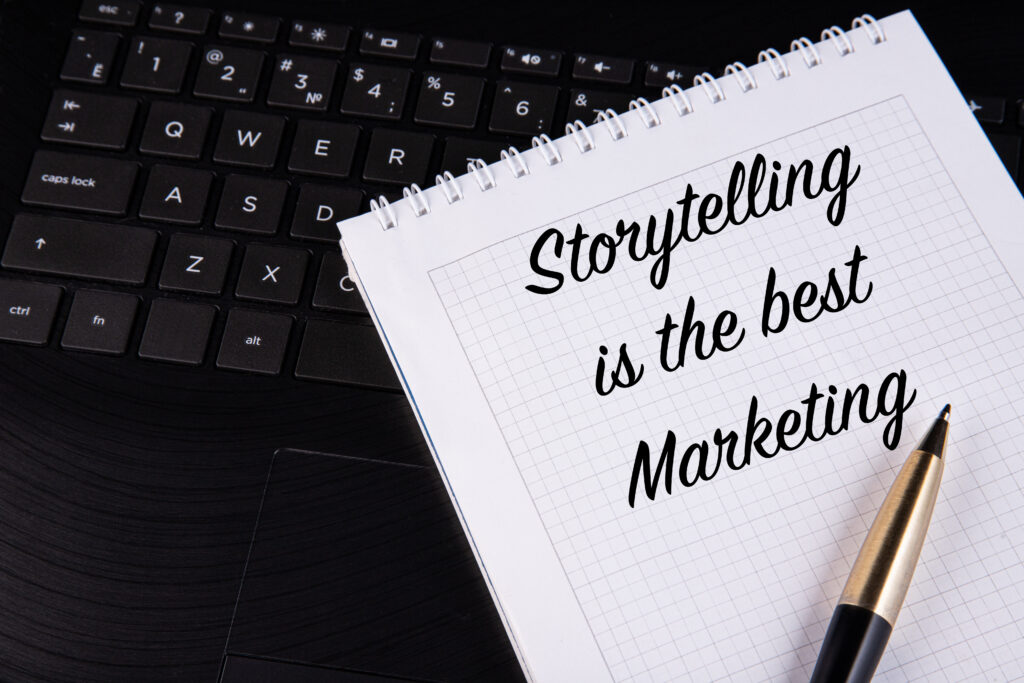
Good storytelling resonates deeply with consumers, triggering empathy and understanding. Its ability to forge an emotional connection between the brand and the audience goes beyond highlighting a product’s features or benefits. Through compelling narratives, brands can convey their identity, values, and mission, making them relatable and memorable. Ultimately, it transforms passive consumers into active advocates, as people not only buy into a product or service but also the image that surrounds it. Brands like Nike have often focused their ad campaigns on celebrity athletes talking about overcoming their struggles, while Dove’s self-esteem project built a whole marketing campaign with stories about body-confidence. Good storytelling allows companies to elevate from a mere commodity to a more cherished presence in the hearts and minds of people. Yes, it also leads to higher engagement, retention rates, loyalty, trust, and uniqueness in the marketplace. But it also allows the brand to stand for something, which is how customers come to trust a brand that shares a similar outlook that they do.
Stories resonate with humans on a profound level because they tap into the core of our shared human experience. At their essence, stories are vessels for transmitting emotions, wisdom, and knowledge from one generation to another. They engage our brains in a unique way, activating both the logical and emotional centres. This dual engagement makes the information contained in a story more memorable and relatable. Moreover, stories provide a safe space for exploring complex emotions and moral dilemmas, allowing us to process and understand our own feelings and experiences through the lens of fictional characters. Ultimately, stories have the power to transcend cultural, linguistic, and generational barriers, connecting people on a fundamental level by touching their hearts and minds, making them a universal and timeless medium of communication. Thus, to build stories that reflect a brand, it is important to note what shared values or experiences you want to highlight.

Understanding an audience’s needs and pain points lies at the heart of effective brand storytelling. It involves deep and empathetic research into the mindset of potential customers. Brands accomplish this by actively listening to their audience through surveys, social media interactions, and customer feedback. They also create detailed buyer personas that represent various segments of their target market, outlining demographics, behaviours, and preferences. One way they can do this is through a technique called empathy mapping, which is a technical process often used in UX and HCI fields to identify and create a bridge of understanding behind your team and the end user. By understanding the thoughts and feelings of a group, brands gain insights into the challenges and pain points their customers face, which then informs product development and marketing efforts. This understanding not only allows brands to tailor their messaging and offerings but also establishes trust and credibility as customers perceive the brand as one that genuinely cares about their well-being, fostering long-lasting relationships and brand loyalty.
Crafting compelling story-based content for your brand is an art that combines creativity, strategy, and authenticity. Begin by aligning your content with your brand’s narrative and values, ensuring consistency in messaging. Develop relatable characters or personas that embody your target audience’s aspirations or challenges, allowing them to see themselves in your story. Introduce conflict or tension to create intrigue and keep your audience engaged, as it’s the resolution of these conflicts that often drives your brand’s message home. Weave emotions into your narrative, as they help form a deeper connection with your audience. Use descriptive language, vivid imagery, and sensory details to immerse your audience in the story. Sometimes, a call to action isn’t even required because your target base has become so emotionally connected to your messaging that they will already be motivated to make a purchase, subscribe, and share the story with others who would be willing to do the same.

Aside from Nike and Dove, there are many companies that have created viral marketing campaigns that not only helped boost sales but moved their companies into the mainstream conversation. Airbnb created a series of host stories, not just through blog articles but short video ads, talking about how homeowners have been able to create better living conditions for themselves using Airbnb’s network. Patagonia has positioned themselves as a company that uses sustainable materials to make high quality, long lasting products, garnering massive support from environmentally conscious customers. Their advertisement was built around a story of “not buying their products” as they showed families wearing the same Patagonia clothing as it’s passed down through multiple generations. Volvo has built its brand image as car safety experts, and their marketing around the stories of people whose lives had been saved in car accidents due to Volvo’s technology has helped magnify that image. Even GoodLife Fitness, the largest fitness company in Canada, created two massively popular campaigns, one around ordinary people being the “heroes” to someone in their lives (Live Your GoodLife) and another around people of different body sizes and backgrounds talking about what makes them feel confident and strong (SexySmartStrong).
As with most campaigns, the execution of a marketing strategy built around a story or narrative depends on many factors. For example, conducting thorough keyword research to identify relevant terms and phrases that align with your brand’s story and the interests of your target audience will help tremendously with search engine optimization as well as measuring analytics.
It’s also very important to be aware of mixed messaging when using an angle to market your company. Context and culture can play a factor as consumers could and do take note of contradictions or confusing messaging. Amazon’s campaign about employee success stories did little to distance the brand from reports of terrible working conditions and low pay in many of its facilities. Furthermore, brands need to be aware of unintended negative reinforcement. Pepsi’s 2017 Kendall Jenner ad, where she hands a police officer a Pepsi at the front of a protest line as a symbol of peace and unity instead drew backlash as it was accused of trivializing important social issues and making protests seem like fun parties. Both Audi and Burger King faced criticism over inadvertently objectifying women, from the former’s story-based ad of a mother inspecting her bride daughter, meant to symbolize the detail of inspection the company takes when building its cars to the latter company’s infamous Women’s Day tweet.

Measuring the impact and success of a story-based marketing campaign can have it’s perceived or assumed results, but it’s important to take a technical approach to ensure that your efforts are achieving the desired outcomes. Start by defining clear key performance indicators (KPIs) that align with your campaign goals. These may include metrics like website traffic, engagement rates, conversion rates, social shares, or even customer sentiment. Utilize web analytics tools, social media insights, and customer feedback mechanisms to collect data on these KPIs. Regularly monitor and analyze these metrics throughout the campaign’s duration, looking for trends and patterns that indicate success or areas that need improvement. A/B testing can also be valuable, allowing you to compare different story elements or variations to determine what resonates best with your audience. Finally, don’t forget to measure the long-term impact, including customer retention and brand loyalty, as the true success of a story-based campaign often extends beyond immediate metrics and reflects in sustained engagement and relationships with your audience.
Incorporating storytelling into your company’s digital marketing strategy is not just a trend; it’s a timeless and powerful approach that can set your brand apart in a crowded digital marketplace. By understanding the art of storytelling, empathizing with your audience, crafting compelling content, and measuring your impact, you can create a narrative-driven strategy that engages, captivates, and converts. The journey you embark on in this guide will empower your brand to tell stories that resonate and endure in the hearts and minds of your audience, ultimately leading to sustainable success in the digital age.
